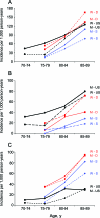The incidence of MCI differs by subtype and is higher in men: the Mayo Clinic Study of Aging
- PMID: 22282647
- PMCID: PMC3280046
- DOI: 10.1212/WNL.0b013e3182452862
The incidence of MCI differs by subtype and is higher in men: the Mayo Clinic Study of Aging
Abstract
Objective: Although incidence rates for mild cognitive impairment (MCI) have been reported, few studies were specifically designed to measure the incidence of MCI and its subtypes using published criteria. We estimated the incidence of amnestic MCI (aMCI) and nonamnestic MCI (naMCI) in men and women separately.
Methods: A population-based prospective cohort of Olmsted County, MN, residents ages 70-89 years on October 1, 2004, underwent baseline and 15-month interval evaluations that included the Clinical Dementia Rating scale, a neurologic evaluation, and neuropsychological testing. A panel of examiners blinded to previous diagnoses reviewed data at each serial evaluation to assess cognitive status according to published criteria.
Results: Among 1,450 subjects who were cognitively normal at baseline, 296 developed MCI. The age- and sex-standardized incidence rate of MCI was 63.6 (per 1,000 person-years) overall, and was higher in men (72.4) than women (57.3) and for aMCI (37.7) than naMCI (14.7). The incidence rate of aMCI was higher for men (43.9) than women (33.3), and for subjects with ≤12 years of education (42.6) than higher education (32.5). The risk of naMCI was also higher for men (20.0) than women (10.9) and for subjects with ≤12 years of education (20.3) than higher education (10.2).
Conclusions: The incidence rates for MCI are substantial. Differences in incidence rates by clinical subtype and by sex suggest that risk factors for MCI should be investigated separately for aMCI and naMCI, and in men and women.
Figures



Comment in
-
Is the development of late-life cognitive impairment more dynamic than sexy?Neurology. 2012 Jan 31;78(5):300-1. doi: 10.1212/WNL.0b013e3182455724. Epub 2012 Jan 25. Neurology. 2012. PMID: 22282646 No abstract available.
References
Publication types
MeSH terms
Grants and funding
LinkOut - more resources
Full Text Sources
Other Literature Sources
Medical
